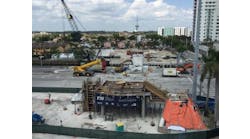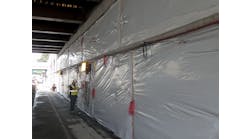Transportation practitioners seeking to learn more about using hydraulic cement concrete (HCC) petrography now have access to an updated resource recently released by the Federal Highway Administration (FHWA). Petrographic Methods of Examining Hardened Concrete: A Petrographic Manual (Pub. No. FHWA-HRT-04-150), complete with procedures, instructions and photographs, is designed to aid practitioners who lack formal petrographic training. Petrographic analysis uses microscopic techniques to study concrete condition and quality, as well as distress, deterioration and failure.
The manual discusses the petrography of HCC, the chemical reactions of rocks and minerals in HCC and the identification of common rocks and minerals necessary for a complete description of HCC. The targeted audience includes petrographers, geologists, engineers, chemists, consultants and university researchers. The manual will be especially helpful in conducting forensic work and troubleshooting problems related to concrete deterioration or in examining mineral aggregates or recycled aggregates. For example, if concrete shows cracking soon after construction, a petrographic analysis can help determine the nature of the cracking and its possible cause.
At present, many of the practitioners performing concrete petrography work are geologists with formal training in optical mineralogy and petrography. Because the petrographic examination of HCC is more qualitative than quantitative, it can be difficult to train new practitioners who lack the field experience in examining HCC and identifying the various features that may indicate the quality of the material. The manual is designed to help close the gap between seasoned practitioners and those new to the field.
Developed in 1992 by petrographer Hollis Walker of the Virginia Transportation Research Council (VTRC), the original manual has been a vital resource to the field of concrete petrology. D. Stephen Lane, senior research scientist at the VTRC, has led the effort to update the publication. New material includes chapters on the use of the scanning electron microscope to examine concrete and concrete-making materials and the identification and classification of rocks and minerals in aggregates. Also added is a chapter on alkali-aggregate reactions, which outlines the process for investigating a case of concrete deterioration and illustrates the features that provide evidence of alkali-silica or alkali-carbonate reactions.
The updated manual also will serve as a valuable tool for the FHWA’s alkali-silica reactivity (ASR) program, which is aimed at preventing and mitigating ASR in concrete pavements and structures. The manual will aid in confirming that structures are affected by ASR and not some other type of deterioration. It also will help in recognizing situations where other deterioration mechanisms may be occurring in conjunction with ASR.
The manual is available online at www .fhwa.dot.gov/pavement/pccp/pubs/04150. To learn more about the FHWA’s pavements and concrete programs, visit www.tfhrc .gov/pavement/pave.htm or www.fhwa.dot .gov/pavement/index.cfm.


